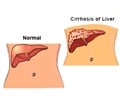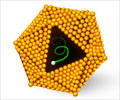A new cause of liver disease has been identified in HIV-positive patients.
A new cause of liver disease has been identified in HIV-positive patients. Investigators in Paris found that 8% of HIV-infected individuals receiving treatment at a specialist liver centre had nodular regenerative hyperplasia, a rare, but potentially fatal, liver disease.
The syndrome involves the build-up of pressure in the portal vein, which connects the intestines with the liver and can cause bleeding into the stomach. Writing in the January 11th edition of the journal AIDS, the French investigators suggest that nodular regenerative hyperplasia is probably under-diagnosed in HIV-positive patients with liver disease, and that antiretroviral therapy should be carefully examined as a possible cause.Liver disease is an important cause of illness and death amongst HIV-positive individuals. The main causes of chronic liver disease in people with HIV are coinfection with hepatitis B or hepatitis C virus; illict drug or alcohol use; insulin resistance; or medication side-effects.
In some patients, the cause of liver disease is unknown and these cases are designed “cryptogenic” - of unknown origin. Liver disease of unknown origin in HIV-positive patients has previously never been fully described, meaning that its causes, clinical importance, and prognosis are unknown.
Investigators in Paris speculated that the rare, but serious, liver disease, nodular regenerative hyperplasia (NRH) could be causing liver disease that could not be attributed to other causes, in HIV-positive patients. NRH is characterised by the presence of widespread regenerative nodules on the liver without significant fibrosis being present. It has previously been observed in a single HIV-positive individual, and was thought to be due to interleukin-2 therapy.
Between early 2003 and mid-2006, a total of 97 HIV-positive patients had liver biopsies at the Necker University Hospital in Paris. Eight of these individuals were diagnosed as having cryptogenic liver disease. The median age of these patients was 39 years, four were men and four were women, all were taking antiretroviral therapy, the median CD4 cell count being approximately 250 cells/mm3, with five patients having a viral load below 50 copies/ml.
Portal hypertension was present in all the patients. Examination of the liver biopsies showed that seven patients had nodular architecture in the liver consistent with NRH, and in the other patient sinusoidial dilation in the context of portal hypertension led physicians to diagnose NRH.
Advertisement
The investigators suggest possible causes of NRH in HIV-positive individuals.
Advertisement
Antiretroviral therapy is also considered as a cause, particularly as between 8 - 12% of individuals who take anti-HIV therapy experience hepatic side-effects. The investigators note, however, that none of the classes of antiretroviral drugs have, to date, been associated with vascular liver disease. Yet, they also observe that all the patients had a history of therapy with ddI, which an earlier case-controlled study showed to be associated with cryptogenic liver disease.
HIV itself is also considered as a cause, particularly as the infection has been associated with pulmonary hypertension. They speculate that the virus might have a similar effect on the liver. HIV can also increase the chance of thrombosis, and they suggest that this, combined with ddI therapy could result in blood clots in the liver leading to NRH.
“We have described a case series of eight consecutive cases of HIV-associated NRH corresponding to a prevalence of approximately 8% over a period of three years on our ward”, they add, however, “this prevalence is probably underestimated.”
The authors recommend that clinicians should consider a possible diagnosis of NRH if they are treating a patient with liver disease of unknown origin.
They conclude that much is still unknown about NRH in HIV-positive individuals, including its causes, prevalence, and optimal management. Regarding the potential causes, the authors recommend that antiretroviral “toxicity should be carefully examined.”
Source: Bio - Bio Technology
SRM











